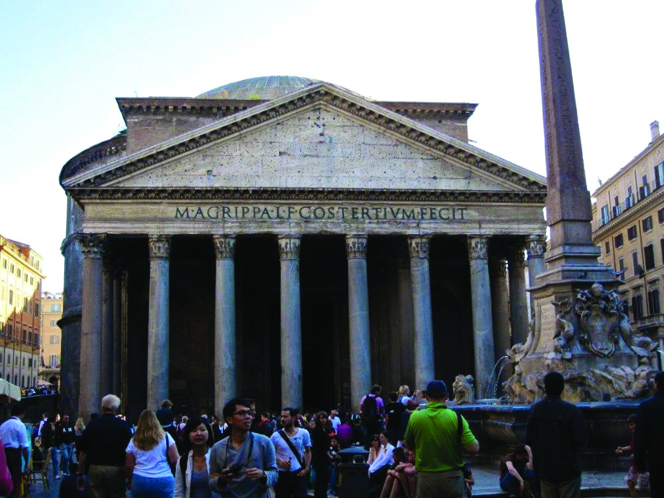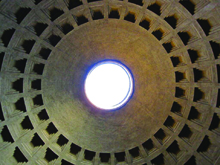The name Pantheon means dedicated to all gods, ‘pan’ means all and ‘theos’ means gods. This most spectacular ancient temple, located in the centre of Rome, inspires awe now, but it would have been truly worthy as a gift to all gods if seen during the classical period…
The emperor Hadrian (76-138AD) rebuilt the almost ruined temple at the beginning of the 2nd century AD. Hadrian was a Greekophile – so much so that he was nicknamed the Greekling – and he nursed a deep passion for the arts and philosophy. He was a dilettante architect and is personally accredited as being the architect of the Pantheon. The temple’s structure is a harmonious synthesis between Greek and Roman architecture. The front of the temple is reminiscent of Greek buildings using the post and lintel construction topped with a pediment, and behind this the circular temple plan is quintessentially Roman (the civilization which used the semicircular arch to its greatest advantage). The arch enabled the Romans to expand and conquer – the aqueduct, a structure formed with arches, meant that they could bring water anywhere they wished.
The circular temple has the same width as height, and a sphere could fit snugly inside the structure. The perfect proportions exude a sense of harmony and balance to the visitor. When inside, with the doors closed, the only light source is from the oculus above. The marble floor is original and the coffered circular roof was once gilded, so half the structure would have glowed as if imbued with the divine. The circular roof is entirely made out of unreinforced concrete which puzzled and amazed historians for centuries in the modern era. The Romans built wood centring and poured the concrete in, packing it down so as to rid the material of any air. So as to alleviate the weight of the dome, the concrete makeup changed according to its position. The ingredients of the concrete closer to the top are tufa stone and volcanic ash, which are very light.
The bronze, which once decorated the roof on the exterior, was removed in the Baroque period to make weapons. Interestingly, this bronze made its way back home to the Pantheon when the canons made from this roof were melted down to make the tomb for Vittorio Emanuele II, who rests in the interior. The front once had bas relief decoration on the tympanum within the pediment. The writing underneath M AGRIPPA L F COS TERTIUM FECIT, means Marcus Agrippa, son of Lucius, made this building when consul for the third time. This refers to the previous structure from the century before that Hadrian rebuilt.
The structure survived the centuries relatively well, unlike the fate of so many other pagan buildings, because in the 7th century it was given as a gift to the Pope from the Roman Emperor. The temple dedicated to all gods was then dedicated to the one Christian god, and most specifically dedicated to the Virgin Mary and all martyrs.


